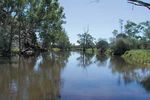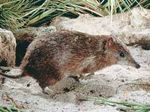OPERATION RANGELANDS RESTORATION A 2020 VISION - Parks and ...
←
→
Page content transcription
If your browser does not render page correctly, please read the page content below
Operation Rangelands Restoration A 2020 Vision
O
ver the past 200 years, Australia has experienced a higher rate of mammal
extinctions than any other continent. Arid regions, including much of the
Western Australian rangelands, have been most affected. Of the 85 species of
native mammals (excluding bats) known to have once occupied the arid zone, 11 are
now extinct, six are extinct on the mainland and are found only on off-shore islands
and 16 are now severely restricted in their range.
Preventing further extinctions and reversing the rate of decline of biodiversity and
ecosystem health in the rangelands will require proactive and determined intervention.
Conservation and natural resource management (NRM) agencies such as the Western
Australian Department of Environment and Conservation (DEC) will work in
partnership with neighbouring landholders, traditional owners, regional NRM groups,
research institutions such as universities and CSIRO, resource developers and other
businesses that have interests in the rangelands.
Brushtail possum
What is the goal of
Operation Rangelands Restoration?
The goal of this unique, ecologically integrated project is to restore natural ecosystem
function and biodiversity, including the reintroduction of 11 arid zone mammal species,
to almost 600,000 hectares of rangelands in the north-eastern Goldfields of Western
Australia by 2020. As well as tangible conservation outcomes, the knowledge and
management experience gained from this project will have application across the semi-
arid and arid rangelands of Australia.
European fox
This will be achieved by:
1. Controlling introduced herbivores including feral camels and feral goats.
2. Controlling introduced predators – feral cats and foxes.
3. Implementing ecologically appropriate fire regimes to maintain functioning
habitats and to reduce the risk of large, damaging wildfires.
4. Reintroducing native mammals that have become extinct or have severely
declined due to introduced predators and herbivores and altered fire regimes.
These reintroductions will improve the conservation status of arid zone mammals
and, in doing so, return many important ecological functions such as soil
cultivation through digging and burrowing, nutrient recycling, seed dispersal and
grazing and browsing.
5. Monitoring reintroduced fauna, introduced predators and herbivores and
biodiversity and ecosystem health.
Red-tailed phascogale
3Boodie Sydney Heads, Earaheedy
Recognised as a world leader in fauna conservation through the widely acclaimed Western Shield program, and having a
strong wildlife conservation science and management capability, DEC is well placed to work towards preventing further
declines in biodiversity and restoring the former native mammal diversity of the WA rangelands. In addition to conserving
some of Australia’s most rare and endangered native animals, Operation Rangelands Restoration will develop science-based
technologies and tools for conservation and environmental management in the rangelands.
The project builds on more than a decade of research and operational experience by DEC, which has resulted in the successful
development of an introduced predator baiting strategy for the arid zone, including a strategy to control feral cats, and fire
management guidelines for hummock grasslands.
Mammal reintroductions in the arid zone, except for fenced areas, have not been successfully achieved before in Australia
primarily because of an inability to control feral cats. Given recent advances by DEC scientists in feral cat control techniques,
this project represents an opportunity to take a leap forward in the conservation of Australian mammals.
Where will Operation Rangelands Restoration
take place?
Operation Rangelands Restoration will be carried out on adjoining ex-pastoral leases –
Lorna Glen (Matuwa) and Earaheedy (Kurrara Kurrara) – some 150 kilometres north east
of Wiluna. Comprising some 565,000 hectares within the Gascoyne and Murchison
Interim Biogeographic Regionalisation for Australia (IBRA) regions, the Lorna Glen-
Earaheedy complex was acquired by the WA Government in 2000 for the conservation
reserve system under the auspices of the Gascoyne-Murchison Strategy. The properties
have been reverted to unallocated Crown land with the intention they will be made into a
conservation park. The Lorna Glen-Earaheedy complex has characteristics that make it
highly suitable for this project, including:
• it is a large area and is typical of the arid zone rangelands ecosystems from which
medium size native mammals have declined;
• it contains diverse landform systems and associated diversity of habitats
representative of much of the Murchison-Gascoyne rangelands; Feral cat
• the vegetation is mostly in good condition with good diversity of plants, reptiles and
small mammals;
• there is a good knowledge base including landform system maps, extensive
biological survey, sub-fossil and other evidence of mammals that once occurred in
the area, fire history and fire ecology;
• introduced herbivores have been virtually eradicated;
4Operation Rangelands Restoration A 2020 Vision
• sustained control of introduced predators (feral cats, foxes and wild dogs) by aerial
baiting has been demonstrated over the past four years;
• a fire management plan has been prepared and is being implemented;
• a network of biodiversity monitoring sites has been established;
• there is good infrastructure including an airstrip, buildings and on-site caretakers;
• there is good access by way of existing roads and tracks; and Bilby
• boundary fences have been upgraded.
What is the project time frame?
A considerable amount of preparation, planning and ground work has been
undertaken in the project area during the past four years. An intensive level of activity
will occur over the next two to three years (2007-2009) associated with Stage 1 of the
mammal reintroductions (reintroduction of bilbies and brushtail possums). Following the
success of Stage 1, reintroduction of another nine arid zone mammals is scheduled over
the period 2009-2020. Introduced predator and herbivore control, fire management Western barred bandicoot
and monitoring will be on-going.
Who is involved with Operation Rangelands
Restoration?
The Operation Rangelands Restoration project was initiated by DEC, through a project
team that includes staff from its Goldfields Region (Kalgoorlie), Science Division and
Nature Conservation Division. The Wiluna traditional owners, who are excited by the
prospect of the return of native mammals, are involved through a joint management
MoU with DEC. In addition, the project has attracted the involvement of students and
academics from local and international universities. Perth Zoo will breed some of the
animals to be reintroduced.
Traditional owners burning at Lorna Glen Numbat
5Which mammals are being
reintroduced?
Sub-fossil evidence and Western Australian Museum records
provide detailed insight to native mammals that occurred in the
area until recently, but which are now locally extinct. The long-term
goal is to re-establish viable populations of a suite of mammals.
Reintroductions will be staged, beginning with species that are
known to be quite robust, that will act as ecosystem engineers and
will have the greatest chance of persistence. Candidate species for
reintroduction include:
Chuditch
• Bilby (Macrotis lagotis) – Vulnerable; locally extinct.
• Brushtail possum (Trichosurus vulpecula) – not threatened, but
locally extinct.
• Boodie (Bettongia lesueur) – Vulnerable; healthy island
populations but extinct on the mainland (except for fenced
populations on Heirisson Prong and Dryandra woodland).
• Mala (Lagorchestes hirstus) – Vulnerable; extinct on the
mainland, three island populations.
• Golden bandicoot (Isoodon auratus) – Vulnerable; extinct in
the arid zone, healthy island populations, mainland
populations persist in the Kimberley region.
Shark Bay mouse
• Western barred bandicoot (Perameles bougainville) –
Endangered; extinct on the mainland (except for fenced
population on Heirisson Prong), occurs on three islands.
• Numbat (Myrmecobius fasciatus) – Vulnerable; extinct in the
arid zone, but persisting in the south-west of WA.
• Red-tailed phascogale (Phascogale calura) – Endangered;
extinct in the arid zone, but persisting in the south-west of
WA.
• Chuditch (Dasyurus geoffroii) – Vulnerable; extinct in the arid
zone, but persisting in the south-west of WA.
• Shark Bay mouse (Pseudomys fieldi) – Vulnerable; extinct in
Golden bandicoot
the arid zone, restricted to three islands.
• Pale field-rat (Rattus tunneyi) – not listed as threatened but
has suffered a large range contraction and is locally extinct.
6Operation Rangelands Restoration A 2020 Vision
Sydney Heads Pass, Earaheedy Lindsay Gordon Lagoon, Lorna Glen
Where will the animals come from?
Bilbies, western barred bandicoots and mala will be sourced from DEC’s captive
breeding programs at the Dryandra Captive Breeding Facility and the Peron Captive
Breeding Centre. Brushtail possums will be sourced from healthy extant wild
populations in the Wheatbelt. Boodies, golden bandicoots and Shark Bay mice will be
sourced from healthy populations on off-shore islands. Chuditch, pale field rats and
red-tailed phascogales will be captive bred at Perth Zoo.
Rufous hare wallaby
How will the animals be monitored when
they are released?
The released animals will be fitted with small radio transmitters and monitored
continuously for at least the first three months after they are released. Radio-tracking,
together with an ongoing trapping program, will provide valuable information about
their survivorship, breeding, home range, dispersal, diet and habitat utilisation and
population dynamics. The sandy roads and tracks in the release area will also be used
to monitor animal activity.
What are the animals' chances of survival?
Research scientists are confident that with effective fox and feral cat control, and
appropriate fire management, the animals have a good chance of establishing. If the
animals fail to establish, scientists will obtain valuable information about why they
became extinct in the first place, leading to better conservation management in the
rangelands. Tall mulla mulla
7Hakea minyma
For more information, contact DEC’s Goldfields Region office on (08) 9080 5555
www.dec.wa.gov.au
2007353-09-200You can also read



























































